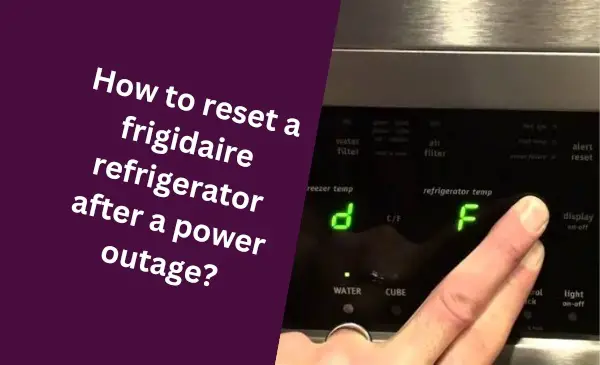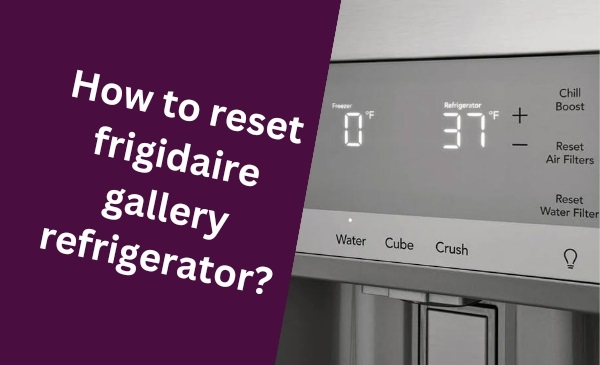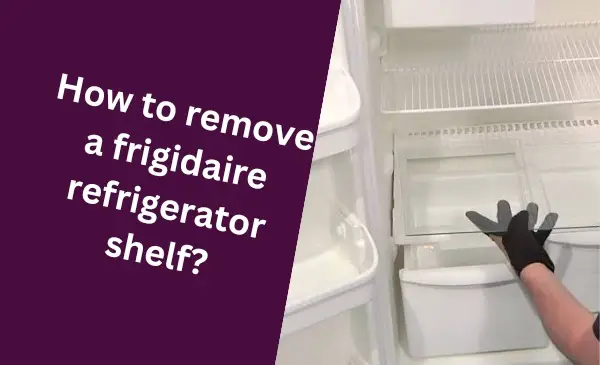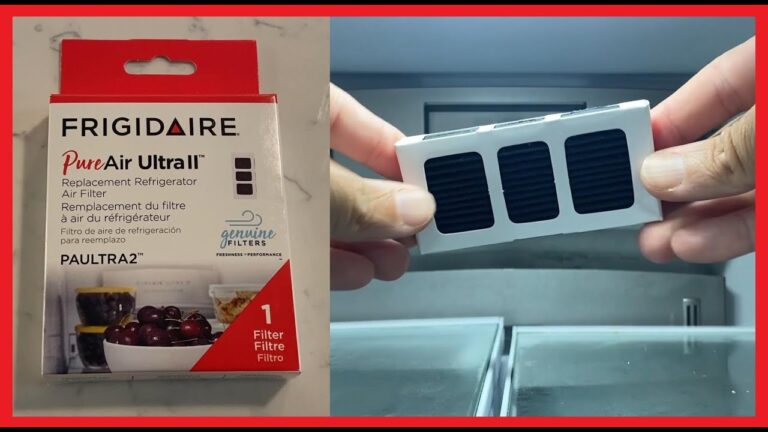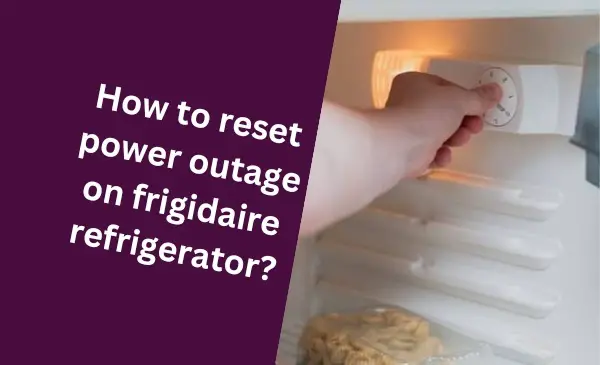Is your Frigidaire refrigerator not making ice? If so, you’re not alone. Many people experience this problem at some point. The good news is that it’s often a relatively easy fix. In this article, we will walk you through the steps on how to repair an ice maker on a Frigidaire refrigerator.
Frigidaire refrigerators are known for their reliability and durability. However, even the best appliances can sometimes have problems. One common issue is a malfunctioning ice maker. This can be caused by a variety of factors, such as a clogged water line, a faulty ice maker motor, or a problem with the water inlet valve.
In this article, we will provide you with a step-by-step guide on how to repair an ice maker on a Frigidaire refrigerator. We will also discuss some common causes of ice maker problems and how to prevent them in the future.
Common Issues With The Ice Maker
The ice maker is an essential component of your Frigidaire refrigerator that ensures a steady supply of refreshing ice cubes. However, like any other appliance, it can sometimes encounter issues that hinder its performance. In this section, we will discuss the most common problems you might encounter with your Frigidaire refrigerator ice maker and provide solutions to help you get it back to its optimal condition.
Ice Maker Not Producing Ice
If your ice maker is not producing ice, it can be quite frustrating, especially during hot summer days. There are a few possible reasons for this problem:
- The water supply line might be blocked or frozen. Check the water inlet valve and make sure it is fully open and not clogged. If the water supply line is frozen, gently thaw it using a hairdryer.
- The freezer temperature might be too high. Ensure that the freezer temperature is set between 0 and 5 degrees Fahrenheit (-18 to -15 degrees Celsius) for optimal ice production.
- The ice maker itself might be faulty. In this case, you may need to replace the ice maker module or assembly. Refer to your Frigidaire refrigerator manual or contact a professional for assistance.
Ice Cubes Not Dispensing Properly
Another common issue with ice makers is when the ice cubes do not dispense properly. Here are a few troubleshooting tips to resolve this problem:
- Check if there is any ice blockage in the dispenser chute. Clear any ice buildup that might be causing a blockage.
- Ensure that the ice dispenser motor is working correctly. If you don’t hear any noise when pressing the dispenser paddle, there might be an issue with the motor that requires professional repair.
- Inspect the ice container for any obstructions. Sometimes, a large chunk of ice can get stuck, preventing the dispenser from working correctly. Remove any ice blockages and test the dispenser again.
Ice Maker Making Strange Noises
If your ice maker is making strange noises, it can be quite unsettling. Here are a few possible reasons:
- The ice maker might be out of alignment. Ensure that it is properly installed and aligned according to the manufacturer’s instructions. A misaligned ice maker can create excessive mechanical noise.
- The water pressure might be too high. If the water pressure to your refrigerator is too high, it can cause a humming or vibrating noise in the ice maker. Adjust the water supply valve to reduce the pressure.
- Internal components might be worn out or damaged. If the noise persists, it is recommended to contact a professional for a thorough inspection and potential repair.
Ice Maker Leaking Water
Discovering water leakage around your ice maker can be a sign of an underlying issue. Follow these steps to address the problem:
- Check the water supply line for any leaks or loose connections. Tighten any loose connections or replace the water line if necessary.
- Inspect the ice maker assembly for any cracks or damage. A damaged ice maker assembly might require replacement to resolve the leakage issue.
- Make sure the fill cup is correctly aligned with the water fill nozzle. Misalignment can cause water to overflow and leak. Adjust the position if needed.
By addressing these common issues with your Frigidaire refrigerator ice maker, you can enjoy a consistent supply of ice cubes without any hassles. Remember to follow the manufacturer’s instructions and safety precautions when troubleshooting or repairing any appliance.
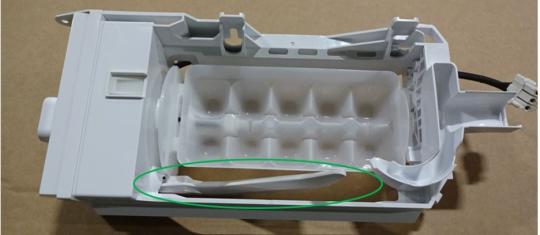
Credit: www.cpsc.gov
Checking The Water Supply
If your Frigidaire refrigerator’s ice maker is not functioning properly, one of the first things you should check is the water supply. Proper water supply is essential for the ice maker to work efficiently. In this section, we will guide you through a few simple steps to ensure that the water supply to your refrigerator is functioning correctly.
Ensuring The Water Supply Is Connected Properly
Firstly, let’s check if the water supply to your Frigidaire refrigerator is connected properly. Make sure that the water supply line is securely connected to the water source and to the refrigerator’s water inlet valve at the back. Check for any kinks, twists, or damage to the water supply line that may be preventing water flow. If the connection is loose or damaged, tighten or replace it accordingly.
Checking For Clogged Water Lines
Clogged water lines can also restrict water flow to the ice maker. Carefully inspect the water supply line for any blockages or obstructions. If you find any debris or mineral deposits, remove them gently using a soft cloth or brush. Ensure that the water lines are clean and clear before proceeding to the next step.
Testing The Water Inlet Valve
The water inlet valve controls the flow of water into the refrigerator’s ice maker. To test the water inlet valve, locate it at the back of the refrigerator. Disconnect the water supply line from the valve and place a container underneath to catch any water. With the water supply line disconnected, activate the water dispenser or ice maker.
If water flows into the container, the water inlet valve is functioning correctly. If no water flows, it may be necessary to replace the water inlet valve.
Adjusting Water Pressure If Necessary
Sometimes, low water pressure can affect the ice maker’s performance. Check the water pressure to ensure that it meets the manufacturer’s recommended range. If the water pressure is too low, it can result in slow ice production or no ice at all.
To adjust the water pressure, locate the shut-off valve connected to the refrigerator’s water supply line. Turn the valve clockwise to increase the water pressure or counterclockwise to decrease it. Make small adjustments and test the ice maker after each change to find the optimal water pressure for efficient operation.
By following these steps to check the water supply on your Frigidaire refrigerator, you can identify and resolve any issues that may be causing the ice maker to malfunction. Now that we have confirmed the water supply is connected properly, checked for clogged water lines, tested the water inlet valve, and adjusted the water pressure if necessary, we can move on to the next troubleshooting steps to get your ice maker back up and running.
Inspecting And Repairing The Ice Maker Components
When your Frigidaire refrigerator’s ice maker is not working properly, it is important to inspect and repair the various components to ensure smooth operation. By examining the ice maker assembly, cleaning the ice maker mold and sensor, replacing a faulty ice maker motor, and testing and replacing the ice maker control module, you can easily troubleshoot and repair the ice maker without the need for professional assistance.
Examining The Ice Maker Assembly
The first step in repairing the ice maker on your Frigidaire refrigerator is to examine the ice maker assembly carefully. Start by removing the ice bin and visually inspecting the assembly for any visible cracks, leaks, or loose connections. It is crucial to ensure that all parts are securely in place and functioning correctly.
Additionally, check the water supply line for any kinks or obstructions that may be preventing water from reaching the ice maker. If you notice any issues, consider replacing or tightening the necessary components.
Cleaning The Ice Maker Mold And Sensor
A common cause of ice maker problems is a dirty or clogged ice maker mold and sensor. To clean these components, begin by turning off the ice maker and removing the ice bin. Locate the ice maker mold and sensor, usually located at the back of the ice maker assembly. Gently wipe the mold with a soft, damp cloth to remove any built-up residue or debris.
Next, clean the sensor using a cotton swab lightly dampened with rubbing alcohol. This ensures accurate readings and improves the overall performance of the ice maker.
Replacing A Faulty Ice Maker Motor
If your Frigidaire refrigerator’s ice maker is not making ice at all, a faulty ice maker motor may be the culprit. Replacing the motor is a relatively simple process. Start by disconnecting the refrigerator from the power source. Locate the ice maker motor, usually located behind the ice maker assembly.
Carefully remove the motor by disconnecting the wires and unscrewing any fasteners. Install the new motor by following the reverse order of steps. Once the new motor is in place, connect the refrigerator back to the power source and test the ice maker for proper functionality.
Testing And Replacing The Ice Maker Control Module
If your ice maker is working but not producing enough ice or is not dispensing ice properly, the control module may need to be tested and replaced. To test the module, use a multimeter to check for continuity and proper voltage. If the module fails the test, it is time to replace it. To replace the ice maker control module, disconnect the refrigerator from the power source.
Locate the module, usually found at the back of the ice maker assembly. Carefully remove the old module and replace it with the new one, ensuring all connections are secure. Finally, reconnect the refrigerator to the power source and test the ice maker’s performance.
In summary, inspecting and repairing the various components of your Frigidaire refrigerator’s ice maker can solve the most common issues without the need for professional help.
By examining the ice maker assembly, cleaning the mold and sensor, replacing a faulty motor, and testing and replacing the control module, you can restore your ice maker’s functionality and enjoy a continuous supply of ice in no time.
Cleaning And Maintenance Tips For The Ice Maker
Maintaining a clean and properly functioning ice maker is essential to ensure a steady supply of ice for your Frigidaire refrigerator. Regular cleaning and maintenance not only extend the lifespan of your ice maker but also guarantee clean and great-tasting ice cubes.
In this section, we will discuss some important cleaning and maintenance tips to keep your ice maker in optimal condition.
Regularly Cleaning The Ice Maker Components
Cleaning the ice maker on a regular basis is crucial to prevent the buildup of dirt, mold, and bacteria, which can affect the quality of the ice. Follow these steps to clean your Frigidaire ice maker:
- Begin by unplugging the refrigerator and locating the ice maker. In most Frigidaire models, the ice maker is located in the freezer compartment.
- Remove the ice bin and empty any remaining ice cubes.
- Wipe the ice bin with a mild solution of water and dish soap to remove any residue.
- Next, use a soft cloth or sponge dampened with warm water and mild detergent to clean the ice maker components, such as the ice mold and the water inlet valve.
- Rinse the components thoroughly with clean water and dry them before reinstalling the ice bin.
Properly Storing The Ice Bin And Dispenser
When not in use, it is important to store the ice bin and dispenser properly to prevent contamination and maintain the ice maker’s functionality. Here are some tips:
- Remove any remaining ice from the bin and wash it with warm, soapy water.
- Rinse the bin thoroughly and let it dry completely before reinserting it into the freezer.
- When storing the ice bin, make sure to cover it with a clean towel or plastic wrap to prevent dust or other particles from entering.
- Additionally, wipe the dispenser area with a damp cloth regularly to remove any residue or spills.
Changing The Water Filter
A clogged or dirty water filter can affect the ice maker’s performance and the taste of the ice cubes. Follow these steps to change the water filter:
- Locate the water filter compartment in your Frigidaire refrigerator. It is usually located in the upper right-hand corner of the fresh food compartment.
- Turn off the ice maker by switching the power button to the “off” position or unplugging the refrigerator.
- Remove the old water filter by twisting it counterclockwise.
- Install the new water filter by inserting it into the filter housing and twisting it clockwise until it locks into place.
- Turn on the ice maker and flush it with a few cycles of water before using the ice cubes.
Preventing Ice Buildup In The Ice Maker
Ice buildup can cause blockages and affect the ice maker’s efficiency. Here are a few tips to prevent ice buildup:
- Avoid overfilling the ice bin, as it can lead to ice overflowing and creating a blockage.
- If the ice cubes are sticking together, gently break them apart to prevent clumping.
- Regularly check the water supply line for any leaks or kinks that can cause water to freeze inside the ice maker.
- Keep the freezer temperature at or below 0°F (-18°C) to prevent excess ice formation.
By following these cleaning and maintenance tips for your Frigidaire ice maker, you can ensure a continuous supply of clean and refreshing ice cubes. Proper care and regular maintenance not only improve the ice maker’s performance but also contribute to the overall longevity of your refrigerator.
Additional Steps For Troubleshooting Complex Issues
Repairing an ice maker on a Frigidaire refrigerator can sometimes be a complex task. While you have already followed the basic troubleshooting steps, there are a few additional steps you can take to further diagnose and fix any underlying issues. In this section, we will explore some of these additional steps to help you get your ice maker up and running smoothly again.
Checking The Freezer Temperature
One common cause of ice maker malfunction is an improper freezer temperature. To ensure that the freezer is cold enough to produce ice, you need to check the temperature settings. Here’s how:
- Open the freezer door and locate the temperature control panel.
- Adjust the temperature settings according to the recommended levels mentioned in the refrigerator’s manual.
- Wait for a few hours and check if the freezer temperature has dropped to the desired level.
Ensuring that the freezer maintains the correct temperature can often resolve ice maker issues.
Verifying The Door Switch Function
The door switch plays a crucial role in the ice maker’s operation. It detects whether the freezer door is open or closed, helping to regulate ice production. To check if the door switch is functioning properly, follow these steps:
- Locate the door switch, usually found near the top of the freezer compartment.
- Press and hold the switch while the freezer door is open.
- Observe if the interior light turns off when the switch is pressed, indicating that it is working correctly.
- If the light does not turn off or there is no resistance when pressing the switch, it may need to be replaced.
Verifying the door switch function can help identify any issues that may be affecting the ice maker’s performance.
Testing The Ice Maker Thermostat
The ice maker thermostat controls the temperature at which the ice maker cycles and produces ice. To test the functionality of the thermostat, follow these steps:
- Locate the ice maker thermostat, usually located inside the ice maker assembly.
- Use a multimeter to test the continuity of the thermostat by connecting the probes to its terminals.
- If the multimeter shows an open circuit, it indicates a faulty thermostat that needs to be replaced.
Testing the ice maker thermostat can help determine if it is causing any issues with ice production.
Inspecting The Ice Maker’s Electrical Connections
Faulty electrical connections can often be a reason behind ice maker problems. To ensure all the electrical connections are secure and functioning correctly, follow these steps:
- Unplug the refrigerator from the power source for safety.
- Inspect the ice maker’s electrical connections, including the wiring harness and wiring terminals.
- Ensure all connections are tightly secured and free from any debris or damage.
- If you notice any loose or damaged connections, carefully reconnect or replace them as necessary.
Inspecting the ice maker’s electrical connections can help resolve any electrical issues that may be affecting its performance.
By following these additional troubleshooting steps, you will be able to better diagnose and repair complex issues with your Frigidaire refrigerator’s ice maker. Remember to always refer to the refrigerator’s manual for specific instructions and safety guidelines.
Frequently Asked Questions For How To Repair Ice Maker On Frigidaire Refrigerator
How Do I Troubleshoot A Frigidaire Refrigerator Ice Maker?
Many issues can cause a Frigidaire refrigerator’s ice maker to malfunction. Check the water supply, ensure the freezer temperature is set correctly, and inspect the ice maker’s components for any problems. Cleaning the ice maker and performing a reset may also help resolve the issue.
Why Is My Frigidaire Refrigerator Ice Maker Not Making Ice?
Several factors can contribute to a Frigidaire refrigerator’s ice maker not producing ice. Check the water supply, ensure the ice maker is turned on, and inspect the water inlet valve and ice maker assembly for any blockages or malfunctions. Adjusting the freezer temperature and cleaning the ice maker may also help.
How Do I Replace The Ice Maker On My Frigidaire Refrigerator?
To replace the ice maker on a Frigidaire refrigerator, first, turn off the water supply and unplug the refrigerator. Remove the ice bin, loosen the mounting screws, and detach the wiring harness. Install the new ice maker, connect the wiring harness, and tighten the mounting screws.
Finally, plug the refrigerator back in and turn on the water supply.
Why Is My Frigidaire Refrigerator Ice Maker Leaking?
A leaking Frigidaire refrigerator ice maker can be caused by a faulty water inlet valve or a clogged water supply line. Inspect these components for any issues or blockages. Additionally, check for any cracks in the ice maker assembly or ice bin that could be causing the leakage.
If the problem persists, consider calling a professional for repair.
Conclusion
Fixing the ice maker on your Frigidaire refrigerator is a simple task that can save you from expensive repairs or the need to replace the entire unit. Following the steps outlined in this guide, you can troubleshoot and repair common ice maker issues yourself.
Remember to regularly clean and maintain your ice maker to ensure its smooth operation. With these tips, you’ll be able to enjoy a frosty beverage without any worries.
Hello Readers, I am Mechanic Shuvo, a seasoned refrigerator solution expert with over 11 years of hands-on experience in the field. Throughout my career, I've dedicated myself to understanding the ins and outs of refrigeration systems, honing my skills as a refrigerator mechanic. My passion for these appliances led me to create the website "refrigeratorsolutionsguide.com," where I aim to share my wealth of knowledge and expertise with others.
Over the years, I've encountered a wide range of refrigerator issues and have successfully resolved them all. From common problems like temperature fluctuations and strange noises to more complex technical issues, I've seen it all. Through my website, I hope to provide practical solutions, insightful tips, and guidance to help you keep your refrigerators running smoothly.


